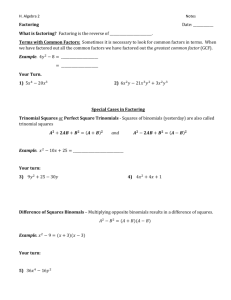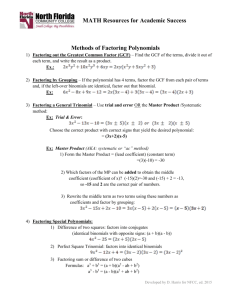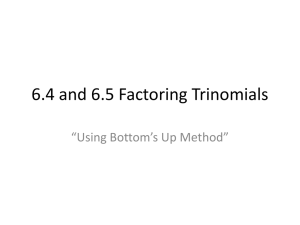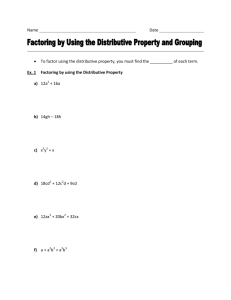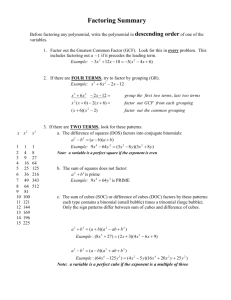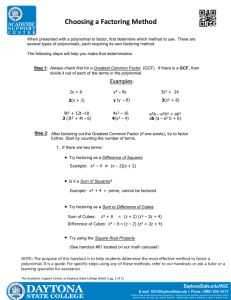NSM100 – Introduction to Algebra Chapter 5 Notes – Factoring
advertisement
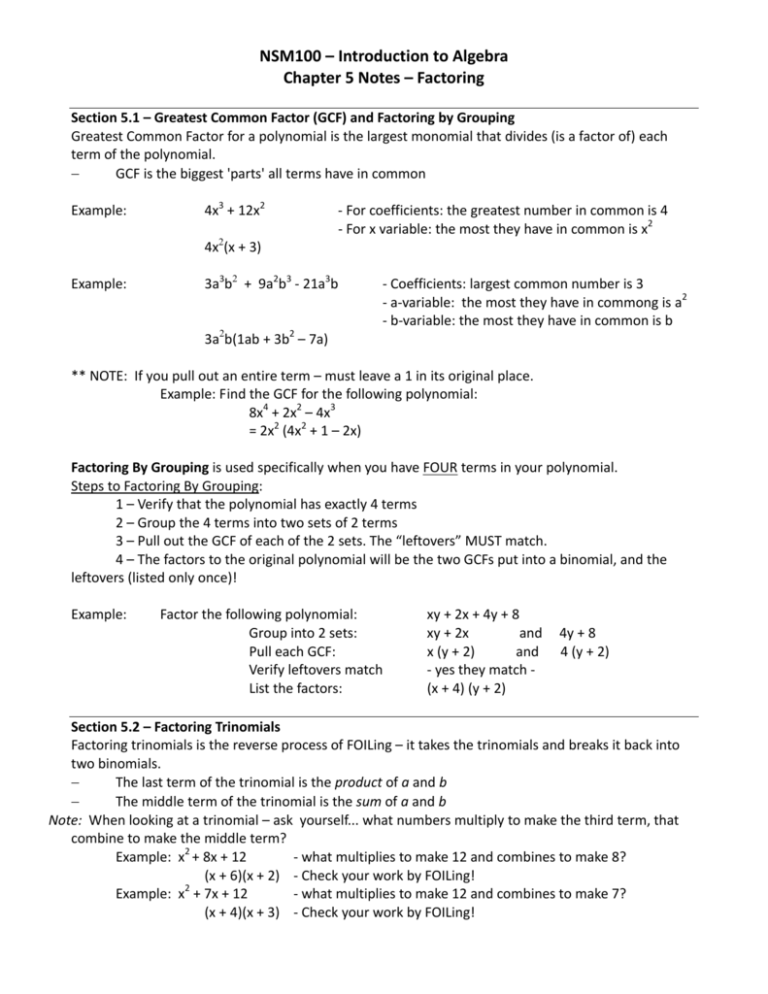
NSM100 – Introduction to Algebra Chapter 5 Notes – Factoring Section 5.1 – Greatest Common Factor (GCF) and Factoring by Grouping Greatest Common Factor for a polynomial is the largest monomial that divides (is a factor of) each term of the polynomial. − GCF is the biggest 'parts' all terms have in common Example: 4x3 + 12x2 ‐ For coefficients: the greatest number in common is 4 ‐ For x variable: the most they have in common is x2 2 4x (x + 3) ‐ Coefficients: largest common number is 3 Example: 3a3b2 + 9a2b3 ‐ 21a3b ‐ a‐variable: the most they have in commong is a2 ‐ b‐variable: the most they have in common is b 2 2 3a b(1ab + 3b – 7a) ** NOTE: If you pull out an entire term – must leave a 1 in its original place. Example: Find the GCF for the following polynomial: 8x4 + 2x2 – 4x3 = 2x2 (4x2 + 1 – 2x) Factoring By Grouping is used specifically when you have FOUR terms in your polynomial. Steps to Factoring By Grouping: 1 – Verify that the polynomial has exactly 4 terms 2 – Group the 4 terms into two sets of 2 terms 3 – Pull out the GCF of each of the 2 sets. The “leftovers” MUST match. 4 – The factors to the original polynomial will be the two GCFs put into a binomial, and the leftovers (listed only once)! Example: Factor the following polynomial: xy + 2x + 4y + 8 Group into 2 sets: xy + 2x and 4y + 8 Pull each GCF: x (y + 2) and 4 (y + 2) Verify leftovers match ‐ yes they match ‐ List the factors: (x + 4) (y + 2) Section 5.2 – Factoring Trinomials Factoring trinomials is the reverse process of FOILing – it takes the trinomials and breaks it back into two binomials. − The last term of the trinomial is the product of a and b − The middle term of the trinomial is the sum of a and b Note: When looking at a trinomial – ask yourself... what numbers multiply to make the third term, that combine to make the middle term? Example: x2 + 8x + 12 ‐ what multiplies to make 12 and combines to make 8? (x + 6)(x + 2) ‐ Check your work by FOILing! 2 Example: x + 7x + 12 ‐ what multiplies to make 12 and combines to make 7? (x + 4)(x + 3) ‐ Check your work by FOILing! NSM100 – Introduction to Algebra Chapter 5 Notes – Factoring If the third term is positive – the binomials have same signs If the third term is negative – the binomials have different signs Example: x2 ‐ 5x + 6 ‐ what multiplies to make 6 and combines to make 5? (x – 3)(x – 2) – Note that the signs in the binomials are the same and are negative. This will multiply to a postive 6 and combine to a negative 5! 2 x – x – 6 ‐ what multiplies to make 6 and combines to make 1? (x – 3)(x + 2) ‐ Note that the signs in the binomials are different!! This will multiply to a negative 6 and combine to ‐1. Also note, the sign of the middle term in the trinomial goes with the larger number! x2 + x – 6 ‐ Note that the signs in the binomials are different. And the positive sign (x + 3)(x – 2) now goes with the 3 because the middle term in the trinomial is positive Section 5.3 – More Trinomials to Factor Trinomials that have lead coefficients are more difficult to factor than trinomials that do not have lead coefficients. There are two main methods (Method 1 and Method 2). Method 1 involves Guess and Check system – you may refer to Example 2 on p. 298 to see an example Method 2 is much more methodical and reliable. Steps To Factoring Trinomials with Lead Coefficients by Method 2 (factoring ax2 + bx + c by Grouping): 1 – Multiply a*c 2 – Find factors of ac that combine to make b 3 – 'Split' the middle term into two terms with factors from step 2. 4 – Factor by grouping Example: 6x2 – 13x + 6 ‐ Multiply a*c : (6)(6) = 36 ‐ What factors of 36 combine to make 13? 1 and 36? no 2 and 18? no 3 and 12? no 4 and 9? YES 6x2 – 4x – 9x + 6 ‐ 'Split' the middle term into two terms with factors from above 2x(3x – 2) and ‐3(3x – 2) ‐ Factor by grouping, leftovers match = (2x – 3)(3x – 2) ‐ List the factors NSM100 – Introduction to Algebra Chapter 5 Notes – Factoring Section 5.4 – The Difference of Two Squares (a + b)2 = (a + b)(a + b) = a2 + 2ab + b2 (a – b)2 = (a – b)(a – b) = a2 – 2ab + b2 (a + b)(a – b) = a2 – b2 therefore.... a2 + 2ab + b2 = (a + b)2 a2 – 2ab + b2 = (a – b)2 a2 – b2 = (a + b)(a – b) If you can recognize the patterns from above, it will make the factoring much easier. Example: x2 + 6x + 9 ‐ exhibits the patterns for binomial squared (x + 3)(x + 3) = (x + 3)2 For the difference of squares – you must recognize that: ‐ the first term is a perfect square ‐ the second term is a perfect square ‐ there is a negative sign between them Example: x2 – 121 (x + 11)(x – 11) Note: The SUM of perfect squares DOES NOT factor!! (Example: x2 + 64) Section 5.5 – The Sum and Difference of Two Cubes The only way to factor two perfect cubes is to use the formulas provided: a3 + b3 = (a + b)(a2 – ab + b2) a3 – b3 = (a – b)(a2 + ab + b2) For the difference of cubes – you must recognize that: ‐ the first term is a perfect cube ‐ the second term is a perfect cube Note: Unlike the difference of squares – the sum of two cubes CAN be factored! Helpful Tip: Take a few seconds to write down what your 'a' value is and what your 'b' value is. Then refer to those while filling in the formulas. Otherwise, it is too easy to accidentally write in the original cubed value. NSM100 – Introduction to Algebra Chapter 5 Notes – Factoring Section 5.6 – Factoring: A General Review Strategy for Factoring a Polynomial 1 – Take out the GCF 2 – Binomial ‐ ‐ check for difference of squares ‐ check for sum or difference of cubes * Remember sum of squares does not factor 3 – Trinomial – does it have lead coefficient? ‐ No – factor over the integers (described in Section 5.2) ‐ Yes – factor using Method 2 (described in Section 5.3) 4 – Four Terms – factor by grouping 5 – Final step – check to see if any of the factors in your answer can be factored further Examples: x2 – 18x + 81 ‐ what multiplies to 81 and combines to 18? (x – 9)(x – 9) = (x – 9)2 ‐‐‐‐‐‐‐‐‐‐‐‐‐‐‐‐‐‐‐‐‐‐‐‐‐‐‐‐‐‐‐‐‐‐‐‐‐‐‐‐‐‐‐‐‐‐‐‐‐‐‐‐‐‐‐‐‐‐‐‐‐‐‐‐‐‐‐‐‐‐‐‐‐‐‐‐‐‐‐‐‐‐‐‐‐‐‐‐‐‐‐ ‐ pull out GCF 3y2 – 9y – 30 3(y2 – 3y – 10) ‐ what multiplies to 10 and combines to 3? = 3(y – 5)(y + 2) ‐‐‐‐‐‐‐‐‐‐‐‐‐‐‐‐‐‐‐‐‐‐‐‐‐‐‐‐‐‐‐‐‐‐‐‐‐‐‐‐‐‐‐‐‐‐‐‐‐‐‐‐‐‐‐‐‐‐‐‐‐‐‐‐‐‐‐‐‐‐‐‐‐‐‐‐‐‐‐‐‐‐‐‐‐‐‐‐‐‐‐ (x2 + 27) ‐ sum of squares, does not factor ‐‐‐‐‐‐‐‐‐‐‐‐‐‐‐‐‐‐‐‐‐‐‐‐‐‐‐‐‐‐‐‐‐‐‐‐‐‐‐‐‐‐‐‐‐‐‐‐‐‐‐‐‐‐‐‐‐‐‐‐‐‐‐‐‐‐‐‐‐‐‐‐‐‐‐‐‐‐‐‐‐‐‐‐‐‐‐‐‐‐ ‐ difference of squares (x4 – 81) (x2 + 9)( x2 – 9) ‐ second factor is difference of squares again 2 = (x + 9)(x + 3)(x – 3) Section 5.7 – Solving Equations By Factoring When trying to solve an equation and factoring is involved, you will factor the problem as appropriate, then set each factor = 0. Standard Form for quadratic equation: ax2 + bx + c = 0 Strategy for Solving a Quadratic Equation by Factoring: 1 – Put equation in standard form (set = 0, lead coefficient must be positive) 2 – Factor completely 3 – Set each factor = 0 (Zero‐factor property) 4 – Solve each linear equation 5 – Check your solutions NSM100 – Introduction to Algebra Chapter 5 Notes – Factoring Examples: 2 a – 11a + 30 = 0 ‐ already in standard form, factor appropriately (a – 5)(a – 6) = 0 ‐ set each factor = 0 a – 5 = 0 and a – 6 = 0 ‐ solve for a a = 5 and a = 6 ‐‐‐‐‐‐‐‐‐‐‐‐‐‐‐‐‐‐‐‐‐‐‐‐‐‐‐‐‐‐‐‐‐‐‐‐‐‐‐‐‐‐‐‐‐‐‐‐‐‐‐‐‐‐‐‐‐‐‐‐‐‐‐‐‐‐‐‐‐‐‐‐‐‐‐‐‐‐‐‐‐‐‐‐‐‐‐‐‐‐ (x + 7) = 2x + 13 ‐ FOIL and simplify x2 + 14x + 49 = 2x + 13 ‐ Move all terms to one side of equal sign x2 + 12x + 36 = 0 ‐ in standard form, factor appropriately (x + 6)(x + 6) = 0 ‐ set each factor = 0 x + 6 = 0 and x + 6 = 0 ‐ solve for x x = ‐6 (same solution twice) 2


